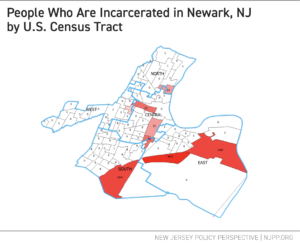On Friday, August 20, Governor Murphy signed legislation that changes how New Jersey counts people who are incarcerated for the purposes of congressional redistricting. Under the new law, people who are incarcerated in the state will be counted at their address prior to incarceration — including at the municipal, county, and regional school district levels — rather than at their detention facility. This builds on existing legislation that enacted the same for state legislative redistricting.
Previously, people who are incarcerated were counted as residents of their facility, but this produced distortions in population and electoral representation. This practice is commonly referred to as “prison gerrymandering” because it resembles other “gerrymandering” methods that manipulate electoral boundaries to advance the political power of one group over another.
With prison gerrymandering, communities where prisons and jails were built receive outsize representation based on their incarcerated population. Conversely, communities that have been disproportionately harmed by mass incarceration have had their populations artificially lowered by their incarcerated population, even though that population will inevitably require services, infrastructure, and representation upon their return.
For example, Maurice River Township in eastern Cumberland County had a population of 6,218 in the 2020 Census. But nearly half of its population, 3,034 residents, were incarcerated (Maurice River Township is home to both Bayside State Prison and the Southern State Correctional Facility). For the purposes of redistricting, the township’s population was nearly doubled, inflating its political representation at the expense of the communities where the people who are incarcerated came from originally.
Because data on the prior addresses of incarcerated people are not currently available, it’s difficult to say how this change will affect the final redistricting population counts. However, based on the Census Bureau’s redistricting file, we can see where incarcerated persons would have been counted under the old system.
Congressional Districts
The three districts most likely to be affected by the change will be Congressional Districts 2, 3, and 10, each of which has about one percent of their population composed of people who are incarcerated. These populations will have to be reallocated to their “home” districts, or in the case of individuals without prior address population, removed from their current district and placed into the statewide total.
Legislative Districts
The districts most likely to be affected by the change at the state level are Districts 29 (Newark), 12 (Jackson), 1 (Vineland), 3 (Bridgeton), and 15 (Trenton), each of which has more than one percent of their population in incarceration. District 29 in Essex County particularly stands out, with 3.7 percent of its population — or 9,349 residents — counted as incarcerated.
Municipalities
The new redistricting rules may have some of the biggest impacts at municipal or local levels. Below is a map of Newark’s ward boundaries, along with the Census tracts and their incarcerated population. Newark’s new 2020 Census count is 311,549 people, yielding ward sizes of roughly 62,309 people for each of the city’s five wards. Within Newark’s current East Ward boundaries, more than 8,000 people were counted as incarcerated in the 2020 Census, representing almost 13 percent of an average ward. If even a fraction of those populations is moved to other cities or wards in Newark, the boundary lines of the East Ward will likely have to expand to ensure that the population respects “one-person-one-vote” principles.

The data from the Secretary of State’s office with final counts for the purposes of redistricting will not be available until after finalized Census figures are sent to the State on September 30. For more information about what the new Census figures mean for New Jersey as a whole, read this breakdown on New Jersey’s demographic and district population changes here.
End Note
This report’s data on people who are incarcerated was generated from the Census Bureau’s Redistricting Summary Files, available at https://www.census.gov/programs-surveys/decennial-census/about/rdo/summary-files.html. For more on the Census Bureau’s data quality and disclosure avoidance system at smaller levels of geography, see: https://www.census.gov/programs-surveys/decennial-census/decade/2020/planning-management/process/disclosure-avoidance.html.

